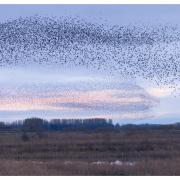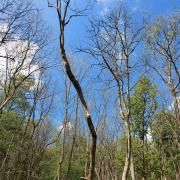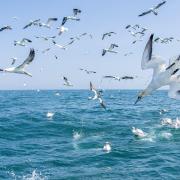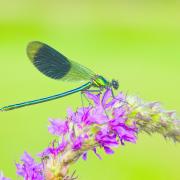With their unrivalled antics in the air, Yorkshire’s harriers are a bird few of us may have heard of, but one that we should all take the chance to encounter, says Yorkshire Wildlife Trust’s Tom Marshall.

For most of us, the harriers probably fall into that slightly unknown category of birds of prey – lacking the glamour or record-breaking limelight of a peregrine falcon, not as showy as the red kite or buzzard and without the mystique or literary profile of the owls.
So how does a bird with such a seemingly small fan base lend its name to one of the most iconic fighter jets in history, and who came up with the best manoeuvres first?
To explore the world of the harrier, we have to travel from the reed-fringed wetlands of our estuaries and lowlands, high onto the moors and uplands.
If any of our harriers can be described as familiar, then it is perhaps the marsh harrier, the largest of the family here in Yorkshire and a bird that can be found surprisingly close to many of our towns and cities.

Extinct across the country by the late 1900s, the marsh harrier – like so many other birds of prey – quietly declined at the hands of persecution and a changing landscape.
The loss of expansive reedbeds once covering large parts of eastern England underpinned their loss, but by the second half of the 20th century a slow return seemed to be on the cards.
As the dwindling numbers of other reedy residents like the bittern and bearded tit began to garner attention, so too the marsh harrier – as top predator of the habitat – snatched the opportunity to pave the way to return as conservationists set about bringing back the reeds.
Along with the traditional strongholds of Norfolk and Suffolk, during the 1980s and 1990s an unlikely ally came in the shape of the digger’s bucket, as gravel extraction pits slowly being returned to nature found their fringes filled with reedbeds.
In parallel with this reverse in fortunes, but far from the hotspots of East Anglia, the Humber estuary was also playing a pivotal role as the RSPB’s Blacktoft Sands became the largest tidal reedbed in the country – and a home for the marsh harrier.
Fast-forward 40 years and today, the marsh harrier has made a welcome return across the county. Semi-urban wetlands such as those at YWT Potteric Carr and RSPB Dearne Valley can boast breeding pairs just miles from town centres, while Hornsea Mere offers a more rural retreat, along with the Yorkshire Wolds at sites such as Tophill Low.
Such is the tenacity and adaptability of the marsh harrier, this summer saw a pair breed at Yorkshire Wildlife Trust’s Skerne Wetlands – a former commercial fish farm, only purchased by the Trust in recent years and in the earliest stages of returning to nature. These more agricultural residences appear to be a new location of choice, similar to their continental cousins.
It’s during the nesting season that lucky observers can catch a glimpse of the harrier’s trademark move, the ‘food pass’. Keen to avoid the relatively risky strategy of delivering a meal straight to a nest in full view of would-be raiders, the male harrier instead takes on a mid-air manoeuvre of dropping the prey, only for the other faithful parent to swing through 180 degrees upside down and clasp the offering mid-flight.
With such an impressive trick in their armoury, alongside a remarkably slow airborne cruising speed of around 20mph, it soon seems obvious where the inspiration for the harrier ‘jump jet’ came from.
But if the marsh harrier’s renaissance is the headline act to a new era for our reedbeds, then sadly the story remains more complex and challenging for their upland cousins the hen harriers.
Slightly smaller and perhaps more agile, the male hen harrier has a haunting, almost ghostly appearance with a pale grey body and wings, the tips generously dipped in an inky black. Like most harriers, the female offers less to impress in her attire – an important attribute when hunkered down in a ground-based nest. Her one distinguishing feature however – a white rump at the base of the tail, has led to the affectionate term of ‘ringtail’.
As the marsh harrier has quietly got on with the job of re-colonising our wetland habitats, the hen harrier’s fortunes have continued on a downward spiral, with well-publicised media reports of persecution at the forefront of conservationists’ concerns.
In the Yorkshire Dales for example, an unsuccessful breeding attempt this summer was the first for at least a decade and today successful hen harrier breeding attempts across England are typically counted in the single figures – if indeed at all.
The balance to be struck for the hen harrier is one that acknowledges that species such as young grouse will inevitably end up on the harrier menu, but that the complete removal of all predators on commercial grouse moors is unsustainable if the harrier is to remain viable as a resident in our uplands.
Through its upland habitat management projects such as the Yorkshire Peat Partnership, the Yorkshire Wildlife Trust has an open dialogue with landowners on the issue, but maintains that the illegal persecution of all birds of prey, including hen harriers, is not acceptable under any circumstances.
If their summer home remains one of ongoing debate, then the winter haunts of the hen harrier on our coastline provide us with an opportunity to witness them in all their finery, not least at evening roosts where several harriers may gather together.
Along with these contrasting stories being played out across Yorkshire, there is also a taste of what the future may bring in the shape of a potential new neighbour for our hen and marsh harriers.
In the vast reedbeds of Blacktoft Sands, recent years have also seen nesting from the much rarer Montagu’s harrier. Similar to the hen harrier in appearance, but with the male bearing a distinctive black line along the wings, the so-called ‘Monty’s’ is a summer visitor, unlike their resident counterparts. Although numbers remain modest and fluctuate year-on-year, this may yet be another species that finds itself increasingly on the list as the UK experiences a warmer climate.
So for perhaps the most unassuming members of the bird of prey family, the future is one of sharp contrast; with the chance for more of us to experience jet power-inspiring antics in our reedbeds, alongside uncertain times that might see the hen harrier not only ghostly in appearance, but as a ghost of our uplands past.
Where to see harriers
RSPB Blacktoft Sands, Goole: marsh harriers all year, Montagu’s harrier in some summers and hen harriers in winter
YWT Potteric Carr, Doncaster: Marsh harrier all year
RSPB Dearne Valley, Barnsley: Marsh harrier all year, occasional hen harrier in winter
Hornsea Mere: Marsh harrier in summer
Tophill Low: Marsh harrier and hen harrier as visitors
YWT North Cave Wetlands: Marsh harrier and hen harrier as visitors



























